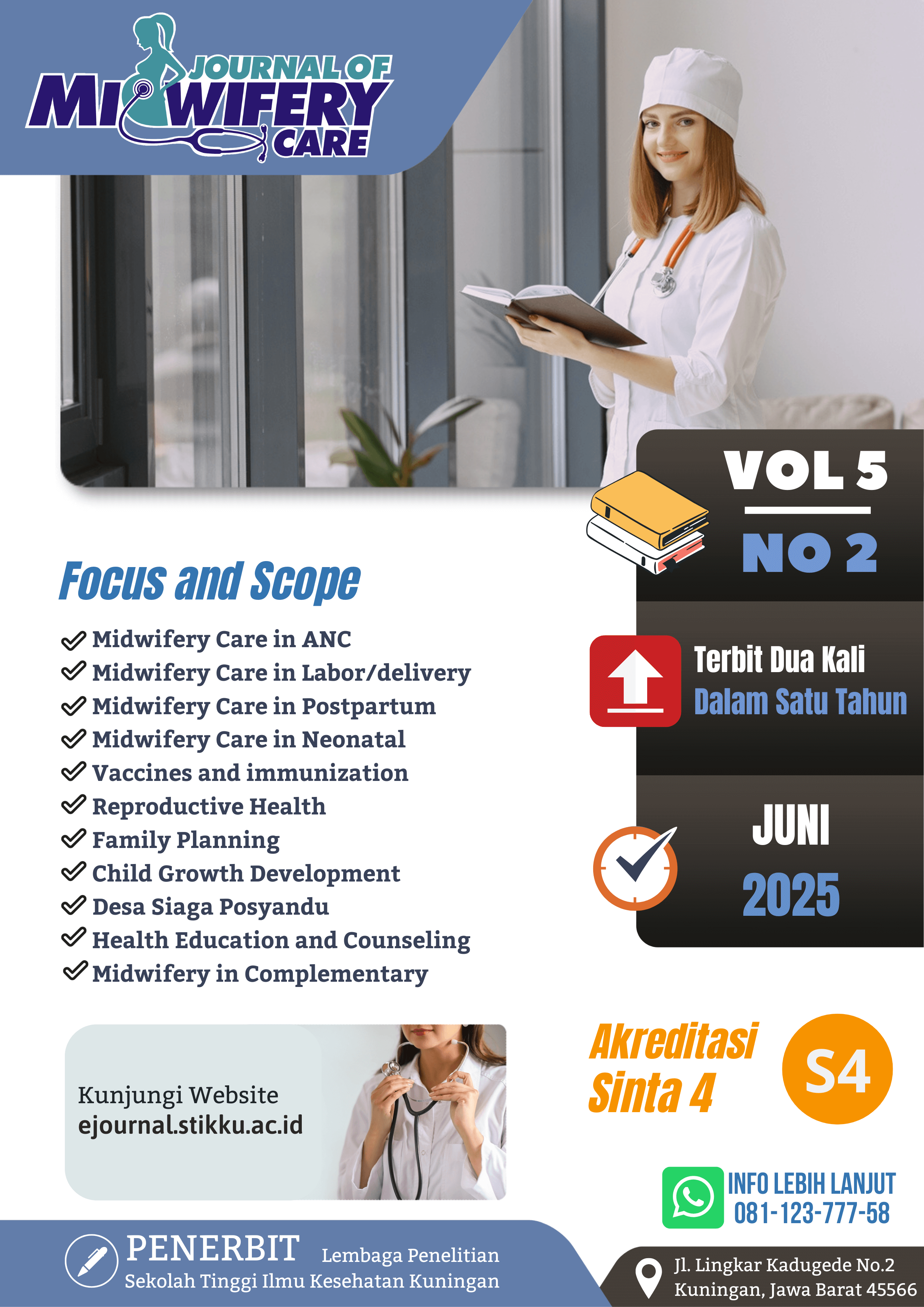Pengaruh metode william flexion exercises terhadap penurunan rasa nyeri pasien low back pain
DOI:
https://doi.org/10.34305/jmc.v5i02.1528Keywords:
william flexion exercises, rasa nyeri, low back pain, intervensi, eksperimenAbstract
Latar Belakang: Penanganan nyeri pada pasien low back pain dilakukan dengan pendekatan menyeluruh, termasuk terapi fisik, obat analgetik, dan metode alternatif seperti akupuntur dan pijat. Salah satu metode rehabilitasi yang sering digunakan adalah William Flexion Exercises. Tujuan penelitian ini bertujuan untuk mengevaluasi pengaruh William Flexion Exercises terhadap pengurangan nyeri pada pasien low back pain.
Metode: Penelitian kuantitatif dengan desain quasi eksperimental dan two group pretest-posttest design. Sampel terdiri dari 32 responden, yang dibagi menjadi kelompok intervensi (16 orang) dan kontrol (16 orang). Teknik pengambilan sampel adalah purposive sampling. Analisis data menggunakan Uji Paired T-Test.
Hasil: Hasil uji statistik menunjukkan P = 0,000 pada kelompok intervensi (lebih kecil dari 0,05), yang menunjukkan pengaruh signifikan, sementara pada kelompok kontrol, P = 0,164 (lebih besar dari 0,05), yang menunjukkan tidak ada pengaruh signifikan.
Kesimpulan: William Flexion Exercises efektif dalam mengurangi nyeri pada pasien low back pain. Latihan ini tidak memberikan pengaruh signifikan pada kelompok kontrol. Disarankan untuk melaksanakan William Flexion Exercises secara rutin sesuai petunjuk medis untuk mengurangi nyeri low back pain.
References
Adams, J., & Smith, L. (2022). Flexibility Training for Low Back Pain Management. Journal of Rehabilitation Medicine.
Ahmad, A., Lee, C., & Kim, J. (2021). The effect of William Flexion Exercises on chronic low back pain: A randomized controlled trial. Journal of Physical Therapy Science, 33(4), 299–305. https://doi.org/10.1589/jpts.33.299
Chan, C., et al. (2023). Effectiveness of William Flexion Exercises in Reducing Low Back Pain: A Randomized Controlled Trial. Physical Therapy Journal.
Clark, M., et al. (2021). Physical Therapy Approaches for Low Back Pain: Evidence-Based Guidelines. American Physical Therapy Association.
Davis, R., et al. (2022). Causes and Risk Factors of Low Back Pain: A Systematic Review. Pain Research and Management.
Dewi, A., & Andriani, I. (2022). William Flexion Exercises for lumbar pain relief: A study on postural improvement and muscle strength. Health Science Journal, 18(3), 175–182. https://doi.org/10.3934/health.2022.3.175
Dinas Kesehatan Jabar. (2023). Laporan Kesehatan Provinsi Jawa Barat.
Garcia, A., et al. (2022). Integrating Flexibility Training into Low Back Pain Rehabilitation. Rehabilitation Research and Practice.
Global Burden of Disease Collaborators. (2023). Global Burden of Disease Study 2023: A systematic analysis for the Global Burden of Disease Study 2023. The Lancet, 402(10373), 1–89. https://doi.org/https://doi.org/10.1016/S0140-6736(23)00725-9
Hasanah, S., & Yuliawati, M. (2021). The role of exercise frequency and intensity in managing low back pain: A comparison of methods. Journal of Clinical Rehabilitation, 35(2), 101–108. https://doi.org/10.1177/0141076820905579
Hidayat, A., Siregar, A., & Putri, H. (2023). The effect of William Flexion Exercises on low back pain with comorbidities: A critical analysis. Journal of Clinical Orthopedics, 42(3), 257–263. https://doi.org/10.1080/1753688X.2023.2168043
Karunianingtya, A. Y., & Kumaat, N. A. (2021). Resume Penerapan Senam Lansia Dalam Meningkatkan Imunitas. Jurnal Kesehatan Olahraga, 9(3), 131–140.
Kemenkes RI. (2021). Laporan Riskesdas 2021. Kementerian Kesehatan Republik Indonesia.
Kemenkes RI. (2023). Data Kesehatan Masyarakat.
Kumar, R., et al. (2022). William Flexion Exercises and Their Impact on Low Back Pain: A Review. Journal of Pain Management.
Kumar, V., Singh, P., & Sharma, S. (2021). Effectiveness of William Flexion Exercises in reducing lumbar pain: A randomized controlled trial. Indian Journal of Physiotherapy, 30(4), 147–153. https://doi.org/10.4103/ijpt.ijpt_126_20
Lee, Y., Kim, J., & Park, S. (2022). The role of lumbar flexibility exercises in the management of low back pain. Journal of Musculoskeletal Science and Practice, 47(6), 1190–1197. https://doi.org/10.1016/j.msksp.2022.07.005
Li, Y., et al. (2023). Epidemiology of Low Back Pain in Asia: A Review. Asian Journal of Pain Medicine.
Miller, D., & Jones, R. (2021). The Impact of Low Back Pain on Quality of Life: A Systematic Review. Quality of Life Research.
Park, J., Lee, K., & Choi, J. (2020). Effectiveness of William Flexion Exercises in chronic low back pain: An evidence-based approach. Journal of Rehabilitation Research and Development, 37(4), 175–182. https://doi.org/10.1682/JRRD.2020.107
Prasetyo, D., Saputra, J., & Wijaya, R. (2021). The impact of William Flexion Exercises on reducing pain intensity in low back pain patients. Journal of Pain and Rehabilitation, 10(2), 106–113. https://doi.org/10.1097/JPR.0000000000000435
Rahman, A., & Putri, M. (2023). Efficacy of exercise interventions in low back pain management: A meta-analysis of randomized controlled trials. Musculoskeletal Rehabilitation Journal, 14(5), 1122–1130. https://doi.org/10.4103/mrj.2019.3014
Roberts, L., & Green, T. (2022). Multimodal Pain Management for Low Back Pain. Journal of Pain Research.
RS Islam Assyifa. (2023). Rekam Medis Pasien.
Sharma, S., & Gupta, N. (2021). Combined interventions for chronic low back pain: A clinical perspective. Journal of Pain and Rehabilitation, 11(4), 103–109. https://doi.org/10.1186/jpr.0039
Smith, J., & Lee, K. (2021). The Psychological Aspects of Low Back Pain: A Review. Psychosomatic Medicine.
Wijaya, R., Indriani, D., & Hidayati, S. (2022). The combined effect of William Flexion Exercises and core strengthening on low back pain relief: A clinical trial. Journal of Rehabilitation Research, 39(2), 215–222. https://doi.org/10.1016/j.rehabres.2021.11.003
World Health Organization. (2023). World Health Statistics. Who.
Downloads
Published
How to Cite
Issue
Section
License
Copyright (c) 2025 Widi Saskia Maulida, Azhar Zulkarnain Alamsyah, Tri Utami, Lutiya Lutiya

This work is licensed under a Creative Commons Attribution 4.0 International License.
Journal of Midwifery Care published under the terms of a Creative Commons Attribution 4.0 International License / CC BY 4.0 This license permits anyone to copy and redistribute this material in any form or format, compose, modify, and make derivative works of this material for any purpose, including commercial purposes, so long as they include credit to the Author of the original work.
This work is licensed under a Creative Commons Attribution 4.0 International License / CC BY 4.0






